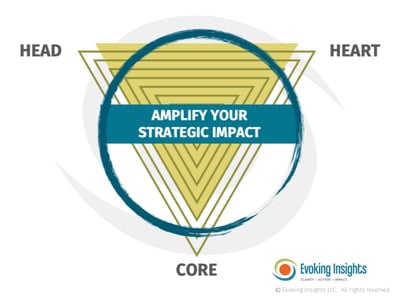Dylan returned to his office, deflated after another frustrating meeting with his colleague. Dylan is a recognized strategist with a clear vision for the future of the organization— a future that requires a significant shift from the way things are. Despite the naysayers, he’s confident in the direction he’s chosen. It is based on a combination of data, analytics, and gut instinct. And yet, the CFO of his company never seems to come around, no matter how much Dylan makes the case through facts and data. Dylan feels stuck, exasperated, and convinced the CFO will never get on board.
Jordan also returned to her office, deflated after another frustrating meeting with her colleagues. Jordan’s a connector – of ideas, of people, of different perspectives. She’s passionate, enthusiastic and has a bit of a sixth sense around people and possibilities. She believes when others may not, without even fully knowing why herself. And while her passion can be infectious, in the strongly data-driven world of biotech, she’s struggling to influence her colleagues to embrace the transformational changes she sees.
In contrast, Kendall is frustrated with herself. While Jordan and Dylan are struggling to bring everyone along to their envisioned future, Kendall’s struggling to envision that future. An engineer by training, she hasn’t met a problem she can’t think her way through and solve. Yet as she develops into her new general manager role, she is finding that the complex problems of strategy require a broader approach. No matter how many times she analyses her current situation, using various tools (i.e., SWOT and PESTLE) – the needed clarity of strategic direction for the business never seems to emerge. She is left with more questions than answers and is highly frustrated with her seeming inability to be strategic.
Each leader is stuck and frustrated. They want to amplify their strategic impact.
Leveraging All Three Intelligences: Which Critical Ingredient are You Missing?
Each leader is facing a situation that finds them relying more heavily on two of our three primary intelligence centers: head (logic), heart (emotion) and core (intuition):
- Dylan is well tapped into his intuition and logical mind.
- Jordan leads easily and naturally from the intelligence of her heart and core.
- Kendall knows the intelligence of the mind well and leverages her care and empathy to develop her leaders.
The path to greater impact is often in the gifts of the untapped intelligence center. As an executive coach, I listen for the missing ingredient to help clients get unstuck. I practice centering myself to bring more of that missing ingredient (or perspective) to our conversations … to see what might become possible.
With Jordan, that’s easy for me—the intelligence of the mind is my go-to. It is also the intelligence center most openly valued and used in the corporate setting. Leaders who more naturally tap into the intelligence of emotion or intuition need to include the intelligence of the mind to be effective (and credible) in making the case for their recommendations.
And yet, the level of complexity in the environment today—particularly in fast-changing industries—requires more than our analytic mind alone, as Kendall and Dylan are experiencing. We need input from all centers of intelligence to manage highly complex decisions and to gain a high level of alignment, commitment, and engagement to those decisions.
Research in neuroscience tells us that the amount of processing power in our conscious mind is relatively limited. When we learn to connect to, and trust in our intuition, we access our own supercomputer—estimated to have processing speed hundreds of thousands of times faster than our conscious mind.
 Daniel Goleman, bestselling author of Emotional Intelligence, led the way in demonstrating the critical value of emotional intelligence in corporate leadership (and beyond). And while the case for emotional intelligence has been made with plenty of research and data (poignantly), many leaders still lack access to the tools, or commitment to the practices, to develop it. Greater effectiveness influencing, managing conflict, navigating change resistance, and gaining buy-in all rest on the foundation of strong emotional intelligence.
Daniel Goleman, bestselling author of Emotional Intelligence, led the way in demonstrating the critical value of emotional intelligence in corporate leadership (and beyond). And while the case for emotional intelligence has been made with plenty of research and data (poignantly), many leaders still lack access to the tools, or commitment to the practices, to develop it. Greater effectiveness influencing, managing conflict, navigating change resistance, and gaining buy-in all rest on the foundation of strong emotional intelligence.
Game‑changing strategic leadership requires the gifts of all three centers of intelligence to navigate:
- tremendous complexity and uncertainty in setting a strategic direction, and
- the discomfort of change, and the nay‑sayers, challengers, and non‑believers in the future we can’t prove.
As Indra Nooyi, former CEO of Pepsi, said in her recent book My Life In Full:
“… the fundamental role of a leader is to look for ways to shape the decades ahead, not just react to the present, and help others accept the discomfort of disruptions to the status quo.”Obstacle to Leading with All Three Intelligences
Each center of intelligence has its gifts and its downsides. All can be overused at the expense of the gifts of the other two. For most clients I’ve worked with, one center of intelligence often is less accessible.
Take intuition, the intelligence of our core.
In many ways, I feel connected to my intuition. It has guided me through major life decisions and transitions. And it often guides me in relationship to others. When facilitating, I sense the energy of a room and use that intuitive information to guide my approach.
And yet, in writing this article, I fell back into my deep habit pattern of over-relying on the intelligence of the analytic mind. It helped me research and think through myriad ideas and facets of the topic – but it ultimately left me feeling stuck in how to arrange all that data to connect with you, my reader.
Leading with intuition requires trust and credibility. Trust in our intuition, AND trust in others, when following their intuitive wisdom. It can be hard to trust intuitive wisdom that lacks concrete evidence, especially when we have been educated to rely on facts and data.
Most senior leaders will line up data in support of their gut instinct, that sense of “just knowing” the right direction, to strengthen their credibility and ability to influence. I started to do the same in writing this article. Helpful—until I ran into the all-too-familiar over-thinking tipping point. The point when decisive action, in this case assertion, was needed more than additional “proof.”
I was stuck and unable to write, as my (unconscious) fear got in the way of access to my intuitive wisdom. My fear of not being credible and able to influence (convince) the doubters of the merits of leading from all three centers of intelligence. And my fear of the real dangers of intuitive leadership outlined in this article:
- “My Way or the Highway” – a particularly triggering one for me
- “Assuming Alignment” – failing to gain team buy-in
- “Not Fully Understanding the Problem” – acting before exploring perspectives
- “Feelings Over Facts” – the risk of ignoring inconvenient truths
As I saw downsides of intuition named, I was able to better access its gifts to break through my stuck-ness in creating this article. I believe in the integrated power of our three intelligence centers. And while that belief rests on both research (head intelligence) and experience (core intelligence), it doesn’t have to be “my way or the highway.” Rather than trying to convince you and prove my belief, I can connect through my emotional intelligence to inspire you to this possibility for greater strategic impact.
A Synergistic Trio—The Gifts of One Mitigate the Limits of Another
The benefits of one intelligence mitigate the risk of another. Emotional intelligence can mitigate the failure to gain team buy-in when over-relying on intuition. Our head intelligence grounds us in knowable facts and data, mitigating the risk of “just knowing.” And our intuition gives us access to the super processor of our subconscious mind that can generate transformational insight, mitigating the risk of over-reliance on what is knowable—in the form of facts and data.
So, the next time you are feeling stuck, try checking in and see which ingredient might be missing for you.
- Dylan is practicing empathy to gain better buy-in from his CFO.
- Jordan is building the data and analytics that support her intuition.
- Kendall is learning to tune out the distractions and fears that prevent her from connecting with, and acting on, her “inner knowing.”
And for me, I was reminded yet again to put down my thinking mind and connect to my emotions, experiences, and intuition. My writing coach asked me, “What does your intuition tell you?” Ugh – her question dropped me to my knees. I was flooded with disappointment. I knew exactly what was needed to cut through all the data I had collected; I just hadn’t paused long enough to receive, and trust in, the intelligence of my intuition.
To unlock the synergistic power of all three of our intelligence centers takes intention and committed practice. We need to constantly keep an eye out for our habit pattern, learning about our fears and obstacles to more readily access that missing piece.
That’s when we take the leap through committed practice, for greater impact.



